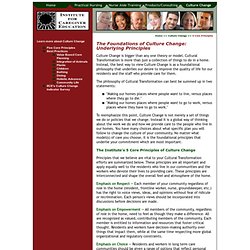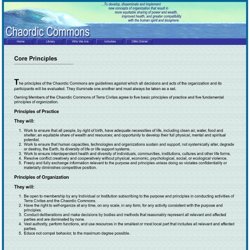

Megacitiesfullreport. Sustainability Helix : Sustainability Dictionary. The Hannover Principles William McDonough and Michael Braungart 1992. William McDonough and Michael Braungart 1992 Insist on rights of humanity and nature to co-exist in a healthy, supportive, diverse and sustainable condition.

Recognize interdependence. The elements of human design interact with and depend upon the natural world, with broad and diverse implications at every scale. Expand design considerations to recognizing even distant effects. Respect relationships between spirit and matter. The Hannover Principles should be seen as a living document committed to the transformation and growth in the understanding of our interdependence with nature, so that they may adapt as our knowledge of the world evolves. source: copyright © 1992 William McDonough Architects Recognize interdependence. Design, Ecology, Ethics and the Making of ThingsA Centennial Sermon delivered by William McDonough at The Cathedral of St. Definitions used in Hannover. The EIDD Stockholm Declaration 2004 - www.designforalleurope.org. The EIDD Stockholm Declaration©Adopted on 9 May 2004, at the Annual General Meeting of the European Institute for Design and Disability in Stockholm.

“Good design enables, bad design disables” Introduction Soon after its establishment in 1993, the European Institute for Design and Disability (EIDD) developed the mission statement: "Enhancing the quality of life through Design for All". After ten years as the European platform on Design for All, involving the development of external relations and an internal structure – national member organisations, corporate members and individual members now in sixteen European countries – EIDD believes that the time has come to issue a Design for All Declaration.
Design for All has roots both in Scandinavian functionalism in the 1950s and in ergonomic design from the 1960s. Comparable concepts have developed in parallel in other parts of the world. Across Europe, human diversity in age, culture and ability is greater than ever. Introduction. Every day, our world gets a little bit smaller and a lot more complex.

So much so that even minor decisions can have major consequences. And not just for trees or frogs or polar bears, but for human lives. And livelihoods. This we know: the planet will go on without us. But we cannot go on without it. Main Principles of LEED. Any building new, or under renovation, can become Leadership in Energy and Environmental Design (LEED) certified.

LEED is a green certification program that takes a "whole building" approach to designing and constructing buildings. LEED certification evaluates a building using key sustainable development principles. Sustainable SitesThe site on which a building is located should only be on previously developed land. Sustainable sites also covers and encourages the building site to only minimally impact the local ecosystem and waterways, use native plants for landscaping, and maximize environmentally friendly transportation options. The site should also work to lessen storm water runoff, light pollution, the building's heat island effect, and pollution during construction of the building.
Water EfficiencyRecognizing that buildings use a large percentage of available drinkable water, this area encourages water efficiency both within the building and outside the building. Untitled. _charter2010_0. _84. Ahwahnee_principles. 10P_SAND_final_lo. Institute for Caregiver Educations Five Core Principles of Culture Change. Culture Change is bigger than any one theory or model.

Cultural Transformation is more than just a collection of things to do in a home. Instead, the best way to view Culture Change is as a foundational philosophy that underlies our desire to improve the quality of life for our residents and the staff who provide care for them. The philosophy of Cultural Transformation can best be summed up in two statements: "Making our homes places where people want to live, versus places where they go to die.
" "Making our homes places where people want to go to work, versus places where they have to go to work. " To reemphasize this point, Culture Change is not merely a set of things we do or policies that we change. Principles that we believe are vital to your Cultural Transformation efforts are summarized below. Emphasis on Empowerment -- All members of the community, regardless of role in the home, need to feel as though they make a difference. 10 Principles of Change Management. Updated: 10 Principles of Leading Change Management This classic guide to organizational change management best practices has been updated for the current business environment.

To read the newest article, click here. Or, to watch a related video, click on the play button above. Way back when (pick your date), senior executives in large companies had a simple goal for themselves and their organizations: stability. Shareholders wanted little more than predictable earnings growth. Market transparency, labor mobility, global capital flows, and instantaneous communications have blown that comfortable scenario to smithereens. This presents most senior executives with an unfamiliar challenge. Long-term structural transformation has four characteristics: scale (the change affects all or most of the organization), magnitude (it involves significant alterations of the status quo), duration (it lasts for months, if not years), and strategic importance. Chaordic_organizations. Commons - Core Principles. T he principles of the Chaordic Commons are guidelines against which all decisions and acts of the organization and its participants will be evaluated.

They illuminate one another and must always be taken as a set. Owning Members of the Chaordic Commons of Terra Civitas agree to five basic principles of practice and five fundamental principles of organization. Principles of Practice They will: Work to ensure that all people, by right of birth, have adequate necessities of life, including clean air, water, food and shelter; an equitable share of wealth and resources; and opportunity to develop their full physical, mental and spiritual potential. Linda Booth Sweeney > Thinking About Systems > 12 Living System Principles. There are living systems on all scales, from the smallest plankton to the human body to the planet as a whole.

When we understand what constitutes a living system, we see that a family, a business, even a country are also living systems. Here is a partial list of enduring understandings related to Living Systems: Interdependence: A relationship in which each partner affects and often needs the other. System Integrity: What a system has when all the parts and processes essential to its ability to function are present. Biodiversity: the variety, complexity, and abundance of species that, if adequate, make ecosystems healthy and resilient. 473-135. Tool-city-of-austin-guidebook. Smart Growth Principles. Livability Principles.